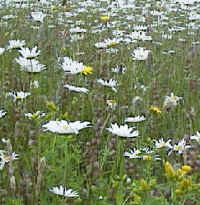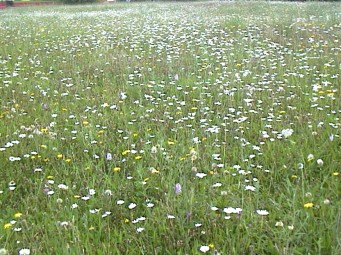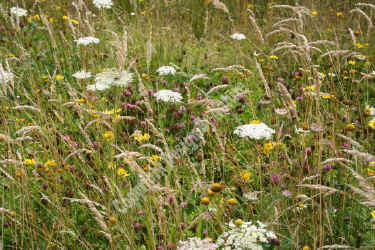| If purchasing this
seed mix, print this page and keep it as your reference.
Native Origin Irish Wildflower Seed Mixture: Range: Meadow Mixtures (Code MM) Supplied without grass, Grass seed can be added Product Name: MM06 Moist Soil (acid / neutral pH <6.5) Product Code: MM06 Description: As so many customers grow this mixture, I have written a long description to explain all Designed for damp soils without lime, it will grow in most Irish
situations bar shade or very dry/limey
Species List: Annuals
15%, Biennials 12.5%, Perennials 72.5%, = Feature Species
On
the Farm: MM06
is stock tolerant from 2nd year with light rate stocking after September
or at least 18 months after sowing, and can be cut anytime from April to May
and again July to September, I believe the best Cream is made from cows grazing on similar meadows found naturally in similar soil types, especially when upland. This is an idyllic pasture or hay meadow mixture. Like all wildflower meadows do not graze until all species are well established. Usually into the 5th year.
All sowing should establish Ragged Robin by the third or fourth year. If not contact us
Mixture Specifications:
Specific weed control at germination The annuals Yellow Rattle, Eyebright and Red Bartsia should persist in well managed meadow or grassland, they require an annual scratching of the surface to surface. Work done after the final cut. Do not expect much success from the Cornfield annuals in this mixture, as often damp acid soils are too cold. Corn Marigold should grow, Poppy rarely, often on a compacted soil that dries out for summer. Redshank is no longer supplied in the mixture, but can be supplied to be sow as a nurse-crop on difficult sites. Redshank if already present will germinate and can smother seedlings, Cut/strim to 4 inches, if mowing, try not damage the crowns of wildflowers below the redshank, as as soon as the redshank is removed the wildflowers will sprout up.
Deisgn, establishment and meadow management notes: A
few of the wildflowers in this mixture in time will form large clumps of colour,
Starting out on moist acid soils The soil that this mixture is best sown on should be prepared a full year in advance. Weed free and stale seed bed control, will control Redshank, Creeping Buttercup and Rush. Dock may be more problematic, as none of the above species ruin the visual appearance, sadly Dock is considered a weed, by those who have never seen the wonderful site of many acres covered solely in dock.
If there is any chance of soil erosion, use green manure, between weed control, or sow late spring, after intensive spring clean up of weeds and 'weed seed in soil genebank,
Sow seed when the soil warms up after March and or before it cools down, usually by mid September. Most species will form small non flowering plants by 3 months, especially Ox-eye daisy, this is an important nurse crop in the second year, again esp' on difficult sites. Annuals will flower later but last longer into winter. Watch out for grass invasion at this stage .A first year cut after all flowering is over will be welcome, or leave it stand the winter for the birds and cut in spring to 10cm.
From the second year onwards, you can give this meadow an High Summer Cut: Time it just after Sorrel or Oxeye daisy die off after flower before these species set seed, if the meadow is left uncut, grasses can invade, so too will creeping buttercup.
If left uncut until September In high to late summer, huge clumps of Meadowsweet, Loosestrife and Yellow Iris will bloom, the meadow can be cut just as the flowers of these species fade to allow the deep blue of Devil'sbit Scabious to flower later on. Or the entire meadow can be left uncut until mid September or later if dry, but
my advice is to cut the wettest areas sown with this this mixture by late July,
before the taller wetland species emerge as this also lets the
Devils Bit flower in the re-growth. Scythes: Remember to cut with scythes, in the early morning when the grass is dewy wet and the stems are like butter, don't wait until afternoon as the job will get difficult as the stem get tougher.
Do not confuse Meadow Buttercup with Creeping Buttercup, which is not included, and may be present on many a clay soil. If creeping buttercup appears: Contact me, Cut the meadow just before the Creeping Buttercup flowers, if the problem gets worse over-sow the meadow with grasses to control infestations. Timing of cutting will control Creeping buttercup and Rush often found on this soil type. In the first 5 years this meadow may have to be topped to 4 inches by July and then in Autumn cut to 10cm to control weeds.
There are few Poppies and no Cornflowers in this mix as they dislike moist acid soil
Sowing into grass: Most of this mixture will grow if sown into existing swords, directions elsewhere on this web.
This photograph is one day in the life of an ever changing meadow
Product Warning: DBN recommends that this mixture is not for human or animal consumption.
Sowing Specification:
ensure a fine tilt or press the seed into clean soil. Sowing
Conditions: Normal, roll or rake into surface to keep out of reach from
birds. be careful to insure the small varieties of seed do not drop to the bottom of the seed spreader and get sown all in the one place. Can be
Hydrasown.
Seed Sowing Rates:
Grass seed or nurse crop requirement: Nurse
Crop: No nurse crop is required. If sown without
grass seed,
this mixture:
Will not require a nurse crop. Performance: germinate 3 - 6 weeks after sowing, from then on, provided the sward is kept
open and a 'Thatch'
is not allowed develop, species will continue to germinate and emerge,
through to the third year. The annuals supplied in this mixture will flower, provided they are sown before June. This
mixture requires one cut when finished flowering. Cut
again in July, August or September, depending on when flower finish or
the level of weeds that emerge. so
flowers will be sparse. However, there should be identifiable foliage
and some flowers. If not contact us. When
should this meadow be established and require one cut? However if the perennials are growing strong there will be no need to cut until August or September depending on the fertility and wetness of the soil and the species which have grown.
A wildflower meadow should last many years, provided the wildflower species were correctly established, weeds were controlled and the meadow was cut and the cut material removed and occasional 'Gaps' are created. If not contact DBN.
Persistence if unmanaged: Low to moderate, High for 10% of
species Disposal of cut materials: Always remove the cuttings, wildflower meadow hay should be removed as soon as possible and not be heaped on site as it will grow mouldy (a health risk). Meadow cuttings can be spread as compost in sheet mulches around trees and shrubs or composted.
Management: Control grasses and weeds until well established. Accept any normal non-invasive weeds as they provide cover, once the sward is established, digging, spot spraying or weed wiping can be used to eliminate problem species. Control weeds, especially Creeping Buttercup, if Creeping Buttercup is present cut this meadow in May in year two. The third year is the critical year to maintain this meadow as scutch grass, creeping thistle, nettle and dock will try to dominate as the growing conditions are ideal for such unwanted species. Most species in this mixture are 'Browse' resistant.
A
General Description of Meadow Range:
Your purchase:
Contributes to DBN's work of creating crops
of Conservation Grade - Native Origin Wildflora. You help us to inform
and pay land-owners to manage native species and to assist DBN in
handing on our heritage for another generation.
|
||


